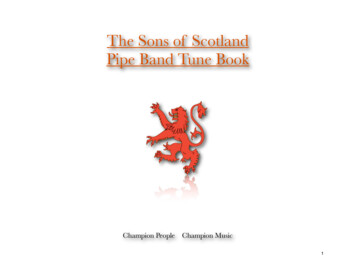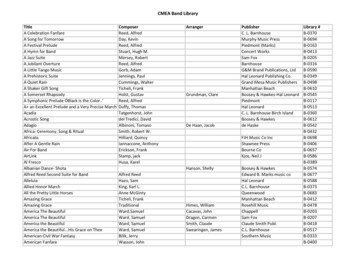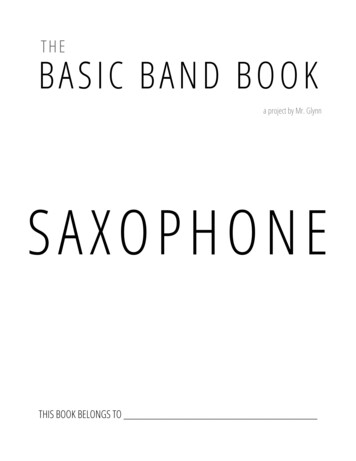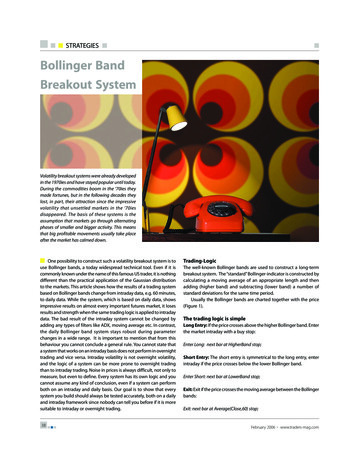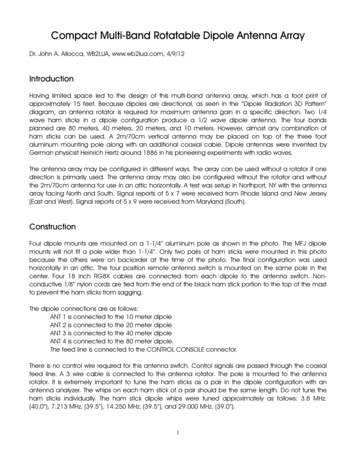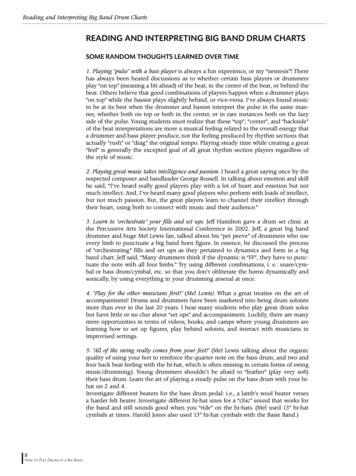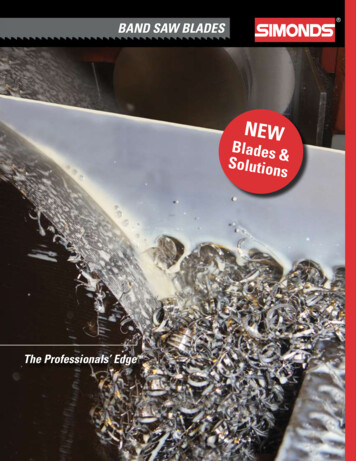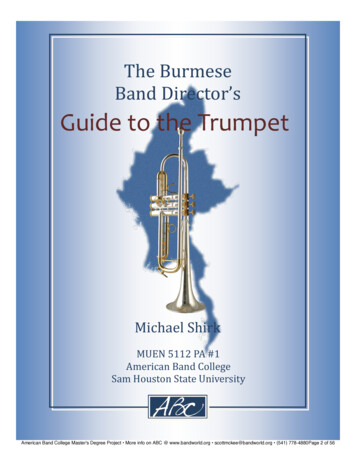
Transcription
The BurmeseBand Director’sGuide to the TrumpetMichael ShirkMUEN 5112 PA #1American Band CollegeSam Houston State UniversityAmerican Band College Master's Degree Project More info on ABC @ www.bandworld.org scottmckee@bandworld.org (541) 778-4880Page 2 of 56
Table of ContentsForeword2What Is a Trumpet6Setting Up for Success8Posture10Holding the Trumpet11Making a Sound12Taking Care of the Trumpet18Trumpet Positions22Trumpet Position Chart24The Overtone Series26Trumpet Intonation28Transposition32Practice34Buying a Trumpet38Trumpet Repair for the Band Director42Introducing the Trumpet to Students48Acknowledgements50Bibliography52Image Sources53American Band College Master's Degree Project More info on ABC @ www.bandworld.org scottmckee@bandworld.org (541) 778-4880Page 3 of 56
ForewordHow It All StartedIn August of 2005, my friend, Allan Villiers, told me he planned to retire after over three decades ofdirecting bands in the state of Washington. He had decided to teach abroad. After putting hisresume online, he had been contacted by an international school in Myanmar. I remember asking,“Where is Myanmar, and what would you do there?” It sounded exotic and challenging and Iwanted no part of it. Having graduated from Central Washington University in December of 2003, Iwas looking to land my first permanent teaching position in small town Washington. In the middleof a sleepless night, however, I began pondering the possibility. I thought, I’m young, single, and if Iever wanted to do something like that, this might be my last chance. So, the next day I called himand told him if he decided not to take the job in Myanmar to give them my name. Exactly threeweeks later I was stepping off the plane in Yangon.In the six years since, I’ve had the great fortune of building asuccessful band program at the International School ofMyanmar. More importantly, I’ve made lasting friendships withmany musicians in the community. My program was the first ofits kind in the nation, as wind instruments – especially westernones – are not commonly taught. In the beginning, my band wasseen as something of a novelty in the community, but recentlythere has been interest in starting bands outside theinternational schools.2American Band College Master's Degree Project More info on ABC @ www.bandworld.org scottmckee@bandworld.org (541) 778-4880Page 4 of 56
About MyanmarA little background about the country: Myanmar, also known as Burma, is situated between Indiaand Thailand, just to the southwest of China. Under British colonialism and with the introduction ofmissionary schools, the educational institutions flourished. After independence in 1948, a weakdemocratic government finally gave way to an oppressive military junta. In 1962 all schools werenationalized and education became tightly controlled for propaganda purposes. Music is nottaught in any public schools. Only the tiny percentage of students wealthy enough to attendmodern international schools are afforded this opportunity. Music does exist, particularly in theChristian communities, but there are few trained professional musicians. There are a few youthstring orchestras, but wind instruments are rare.3American Band College Master's Degree Project More info on ABC @ www.bandworld.org scottmckee@bandworld.org (541) 778-4880Page 5 of 56
Planting the Band SeedSince the introduction of my band program, a few individuals have contacted me, asking advice onstarting wind bands in their churches or communities. I suggest the following things are needed inthis order:1.2.3.4.5.A trained teacherAccess to a professional repair serviceInstrumentsInterested studentsBand literatureUnfortunately, some have tried to start bands without meeting these requirements in order. Oftentheir first step is to purchase instruments, assuming they’ll find a musician – be it a singer, guitarist,keyboardist, or anyone looking for something to do – to lead a group of students. Little thought isgiven to the collection of instruments purchased, and the need for repair never enters the mind!Thus, there is no knowledge of the proper technique or even how the instruments work. As anexample, I once visited a newly founded program with brand new instruments and enthusiasticstudents. On examining the instruments, I discovered a saxophone with so many keys out ofadjustment that it could play nothing other than open C# – and with a terrible tone at that! Onquestioning, I learned that the teacher had no idea the instrument was defective in any way andhad made the reed by cutting a piece of wild bamboo found in the jungle.4American Band College Master's Degree Project More info on ABC @ www.bandworld.org scottmckee@bandworld.org (541) 778-4880Page 6 of 56
Target AudienceThis project, focused on the trumpet and prompted by a requirement of the American BandCollege of Sam Houston State University, is intended to be part of a larger guide aimed ataddressing the training needs of Burmese music teachers working with wind ensembles inMyanmar. It is assumed that anyone reading this book has a basic level of proficiency in music,whether as a singer or instrumentalist. The reader should be able to read music and have a basicunderstanding of music theory. While much of the advice given here is applicable to anyoneteaching band, special consideration is given to the unique circumstances of teaching music inMyanmar. These circumstances include a lack of exposure among much of the population towind instruments and wind ensembles, the ubiquity of low quality instruments, and a lack ofqualified repairmen, making proper daily maintenance and do-it-yourself repair a high priority.Help Make a Difference!Thank you for taking the time to look this over. If you have questions about anything presented ornotice anything lacking or erroneous, please do not hesitate to contact me. To my knowledge, thiswill be the first work of its kind in the nation of Myanmar and a primary resource for Burmesemusic educators. Any input is greatly appreciated in making this a first-rate publication. Feel freeto contact me with suggestions at mrmikeyangon@gmail.com.5American Band College Master's Degree Project More info on ABC @ www.bandworld.org scottmckee@bandworld.org (541) 778-4880Page 7 of 56
What Is a Trumpet?A Member of the Brass FamilyThe trumpet is a member of the brass family of wind instruments. The name “brass” is confusingbecause not all brass instruments are made of brass metal and metal instruments like the modernflute and saxophone are not part of the brass family. Brass instruments are played by blowingthrough the lips to cause them to vibrate inside a cup-shaped mouthpiece. Some other modernbrass instruments are the trombone, French horn, and tuba. Other brass instruments can be foundaround the world, made of everything from sea shells and elephant tusks to plastic, bamboo, andeven tree bark.How Trumpets Are UsedTrumpets have served in many important roles. In some cultures, they are a sign of power andstatus, announcing the arrival of a king or queen. Hunters and fishermen have used them to callfor help. Because their sound carries so well, they have been used to send signals across longdistances. Some religions have used them to call up or drive out spirits. In the West, trumpetsare often used in the military, accompanying marching soldiers and sounding alarms. Asexpressive musical instruments, they have become an important part of the wind ensemble.Development of the Modern TrumpetThe modern trumpet developed over the course of thousands of years. AncientEgyptian trumpets from about 4,500 years ago were short, straight tubes and were usedto accompany soldiers and dancers. Around the year 1400 AD, instrument makerslearned to bend the metal tubing of the trumpet into an S-shape and later into the loopthat you see today. During the 16th century, this looped “natural trumpet” wasstandard.Trumpets up to this time had no valves, so the musician could only play notes out of oneovertone series. (You will learn more about the overtone series later in the book.)During the 18th and early 19th centuries, curved pipes of various lengths could be addedto create more overtone series, but these could not be changed quickly. (Those pipesare called “crooks”.) Players also experimented with putting their hands in the bell tolower the overtone series. Instrument manufacturers had some success adding a slidelike a trombone and these “slide trumpets” are still sometimes used today.Finally, in 1814 the first valve system was introduced. An improvement called thePérinet Piston Valve was invented in 1838 and this is the system found on most moderntrumpets. Rotary valves like those seen on French horns are less common. Moderntrumpets are usually made from brass or some other kind of metal, folded into a tubethat opens into a bell shape, with a separate mouthpiece and three (or sometimes four)valves.6American Band College Master's Degree Project More info on ABC @ www.bandworld.org scottmckee@bandworld.org (541) 778-4880Page 8 of 56
What Is a Cornet?You may see music written for cornet instead of trumpet or astudent may have a cornet and want to join your band. Thedifferences between the trumpet and the cornet are very small.Cornets vary in shape, but the tubing of the cornet is oftenwrapped in a somewhat different shape from the trumpet andthe mouthpiece may appear slightly different. Cornets typicallyplay in the same key and range as trumpets and sound similar,though some describe the tone of the cornet as mellower thanthe trumpet. You can use them as if they are the sameinstrument in your band, using cornets as if they are trumpetsand cornet parts as if they are trumpet parts.What Is a Bugle?Bugles are similar to the natural trumpets discussed previously. Theyusually have no valves and only play the notes of a single overtone series.Unlike the cornet, you would not be able to use a bugle on trumpet parts inyour band. Bugles are usually played as a means of military signaling or inbugle bands as a simple accompaniment for marching.Silver or Yellow?Many of the trumpets sold in Myanmar are silver, but you may also see some that are yellow,gold, black, or other colors. These are only the colors of the plating, paint, or lacquer and do notaffect the sound of the trumpet.7American Band College Master's Degree Project More info on ABC @ www.bandworld.org scottmckee@bandworld.org (541) 778-4880Page 9 of 56
Setting Up for SuccessThe First Day Is ImportantIn the first few lessons, students will pick up the habits and attitudes that will shape how theyapproach their instrument for years. It is easier to teach them good habits from the beginning thanto force them to unlearn bad habits later.AssemblyGuide your students through the assembly process. Lay the case flat on the floor with the lid ontop. Open the case and remove the trumpet.1. Check for any damage.2. Make sure the water keycorks are in place andundamaged.3. Check that the valves areoiled, inserted in the rightorder, and rotated correctly byblowing air into the lead pipeand pressing the valves. If theair way is blocked, the valveshave probably been put inincorrectly.8American Band College Master's Degree Project More info on ABC @ www.bandworld.org scottmckee@bandworld.org (541) 778-4880Page 10 of 56
4. Check that the 1st, 2nd, and3rd valve slides are not stuckby moving each slide whileholding down its valve.5. Look for damage to themouthpiece, being sure theend of the shank is round.6. Insert the mouthpieceshank into the end of the leadpipe with a gentle twist.NEVER tap on the mouthpiece.It may become stuck and needa special tool to remove it.DisassemblyBe sure all the pieces are there before closing the case. If a water key pad has fallen out whilepracticing, it is probably somewhere close to the student’s chair. Finding it a day or a week latermay be impossible. For more advice on caring for the trumpet, see page 18.Put the mouthpiece in the slotdesigned for it. A loosemouthpiece can dent thetrumpet as it rolls around inthe case.Do not put sheet music orbooks in the case with thetrumpet. Laying music on topof the trumpet can putpressure on the 2nd valve slide,leading to a deformed 2ndvalve casing.Close all the latches. Morethan one trumpet has made atrip to the repair shop afterfalling on the floor because itscase opened when the studentpicked it up.9American Band College Master's Degree Project More info on ABC @ www.bandworld.org scottmckee@bandworld.org (541) 778-4880Page 11 of 56
PostureCorrect PostureTeach your students proper playing posture and remind them every day.Sit on the front edge of the chair, not touching the back of the chair.The spine is straight, like standing from the waist up.Shoulders are back and relaxed.Feet are flat on the floor.Thighs are parallel to the ground.If the feet do not reach the floor, they can be placed on a book or other flat object.The trumpet should be angled slightly lower than parallel to the floor.Common Posture MistakesObserve every day whether they are still using good posture. It is amazing to see what kind ofposture they will use if they think you are not watching! Watch out for posture problems, like :Hunching the shouldersLeaning forward with theelbows on the kneesSlouching and/or legs crossed10American Band College Master's Degree Project More info on ABC @ www.bandworld.org scottmckee@bandworld.org (541) 778-4880Page 12 of 56
Holding the TrumpetHand PositionWithout the trumpet, have the student let his or her arms hang loosely. If the student brings thehands up by bending at the elbows, keeping them relaxed, the hands should form a natural “C”shape. This natural, relaxed “C” in both hands is exactly the way the hands will be formed whenholding the trumpet properly. The weight of the trumpet is supported by the left hand.The right hand fingers shouldbe curved, making a backward“C”
The modern trumpet developed over the course of thousands of years. Ancient Egyp an trumpets from about 4,500 years ago were short, straight tubes and were used to accompany soldiers and dancers. Around the year 1400 AD, instrument makers learned to bend the metal tubing of the trumpet into an S-shape and later into the loop that you see today.


